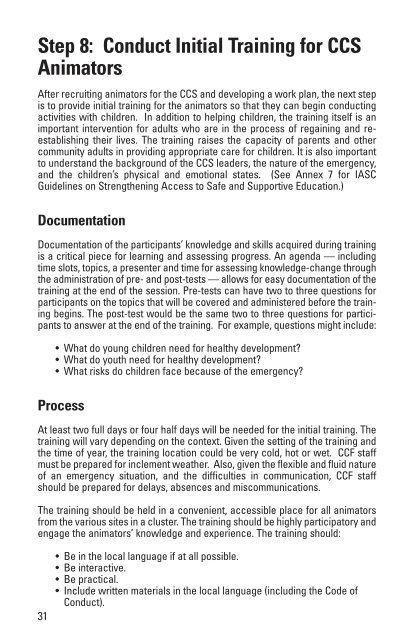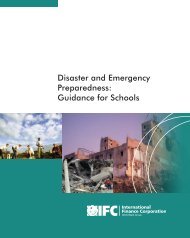Starting Up Child Centered Spaces in Emergencies: A Field Manual
Starting Up Child Centered Spaces in Emergencies: A Field Manual
Starting Up Child Centered Spaces in Emergencies: A Field Manual
- No tags were found...
You also want an ePaper? Increase the reach of your titles
YUMPU automatically turns print PDFs into web optimized ePapers that Google loves.
Step 8: Conduct Initial Tra<strong>in</strong><strong>in</strong>g for CCSAnimatorsAfter recruit<strong>in</strong>g animators for the CCS and develop<strong>in</strong>g a work plan, the next stepis to provide <strong>in</strong>itial tra<strong>in</strong><strong>in</strong>g for the animators so that they can beg<strong>in</strong> conduct<strong>in</strong>gactivities with children. In addition to help<strong>in</strong>g children, the tra<strong>in</strong><strong>in</strong>g itself is animportant <strong>in</strong>tervention for adults who are <strong>in</strong> the process of rega<strong>in</strong><strong>in</strong>g and reestablish<strong>in</strong>gtheir lives. The tra<strong>in</strong><strong>in</strong>g raises the capacity of parents and othercommunity adults <strong>in</strong> provid<strong>in</strong>g appropriate care for children. It is also importantto understand the background of the CCS leaders, the nature of the emergency,and the children’s physical and emotional states. (See Annex 7 for IASCGuidel<strong>in</strong>es on Strengthen<strong>in</strong>g Access to Safe and Supportive Education.)DocumentationDocumentation of the participants’ knowledge and skills acquired dur<strong>in</strong>g tra<strong>in</strong><strong>in</strong>gis a critical piece for learn<strong>in</strong>g and assess<strong>in</strong>g progress. An agenda — <strong>in</strong>clud<strong>in</strong>gtime slots, topics, a presenter and time for assess<strong>in</strong>g knowledge-change throughthe adm<strong>in</strong>istration of pre- and post-tests — allows for easy documentation of thetra<strong>in</strong><strong>in</strong>g at the end of the session. Pre-tests can have two to three questions forparticipants on the topics that will be covered and adm<strong>in</strong>istered before the tra<strong>in</strong><strong>in</strong>gbeg<strong>in</strong>s. The post-test would be the same two to three questions for participantsto answer at the end of the tra<strong>in</strong><strong>in</strong>g. For example, questions might <strong>in</strong>clude:• What do young children need for healthy development?• What do youth need for healthy development?• What risks do children face because of the emergency?ProcessAt least two full days or four half days will be needed for the <strong>in</strong>itial tra<strong>in</strong><strong>in</strong>g. Thetra<strong>in</strong><strong>in</strong>g will vary depend<strong>in</strong>g on the context. Given the sett<strong>in</strong>g of the tra<strong>in</strong><strong>in</strong>g andthe time of year, the tra<strong>in</strong><strong>in</strong>g location could be very cold, hot or wet. CCF staffmust be prepared for <strong>in</strong>clement weather. Also, given the flexible and fluid natureof an emergency situation, and the difficulties <strong>in</strong> communication, CCF staffshould be prepared for delays, absences and miscommunications.The tra<strong>in</strong><strong>in</strong>g should be held <strong>in</strong> a convenient, accessible place for all animatorsfrom the various sites <strong>in</strong> a cluster. The tra<strong>in</strong><strong>in</strong>g should be highly participatory andengage the animators’ knowledge and experience. The tra<strong>in</strong><strong>in</strong>g should:31• Be <strong>in</strong> the local language if at all possible.• Be <strong>in</strong>teractive.• Be practical.• Include written materials <strong>in</strong> the local language (<strong>in</strong>clud<strong>in</strong>g the Code ofConduct).
















